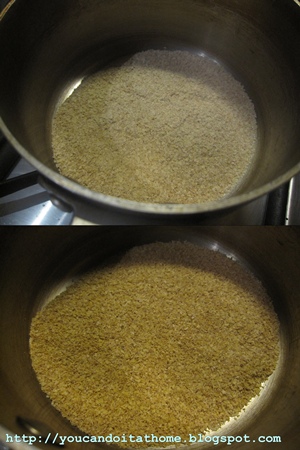
Wheat Germ Sourdough - simple and flavourful
I was amazed how wheat germs enhanced bread flavor when I made David (dmsnyder)'s famous SFBI miche a couple of months ago. I liked it a lot that I wanted to try making more breads with wheat germs.
Well, I can be easily distracted with other baking projects, bread ideas, new books, etc. Now, two months later, I finally got the chance to make a plain sourdough with toasted wheat germs added.
This time, I toasted the wheat germs longer until it was very aromatic and golden, which I believe it added nuttier flavor to the bread.
 before and after the toast (wheat germ)
before and after the toast (wheat germ)
I made a simple sourdough with mixed wheat and whole wheat starter that was fed twice before the final built. The formula has 68% hydration, 10% whole wheat flour and 2% toasted wheat germs.
I had been more vigilant with the 'desired dough temperature (DDT)' for the past few weeks as the weather was getting cooler in Melbourne, the temperature is now sitting around 10-14 C in the early morning and evening (when I prepare my starter and/or final mixing). I started to notice that the dough was rather slack without adhering to DDT (as a result of me being slack on the DDT). So, I am now back to the business measuring the temperature of ingredients and adjusting the water temperature to achieve DDT.
I am quite happy with the flavor of this bread. It was a simple sourdough with a small amount of wheat germ that did such a wonder to the flavor. I also love the flavor that mixed flour starter produced, pronounced acidic tone. The bread had a lovely chewy texture.
Full post and recipe is here.
Sue


Comments
Nice, Sue. :) Ever since I made that miche I have been in love with the flavour that toasted wheat germ brings to a loaf. Every now and then, I will add some to my ordinary sourdough. It really has a special flavour.
All the best,
Syd
I'll have to try to add the wheat germs to more breads. Apart from loving the flavour, I think my wheat germ might go rancid pretty soon. This thing won't last very long after the bag is opened.
Sue
Sue, keep it in the freezer. It will stay fresh for ages. Months, even a year. I have had some in my freezer for over a year and it is still as fresh as the day I bought it. :)
Syd
for the tip. That's great, I'm putting they in the fridge now. The freezer is rather full:(
Sue
Like you, Sue and Syd, I have added toasted wheat germ to other breads after trying David's flavoursome SFBI miche recipe. It always gives the flavour added dimension.
Another nice-looking bread, too, Sue!
I'm not so sure about the DDT being such an important factor, though. For me, lower ambient temperatures just mean longer autolyses and proofs - and the longer the proof, the better the flavour it seems to me. I reckon winter is the best bread baking time for this reason.
Cheers!
Ross
Yes, that would make a gang of three, I totally love the flavour. It sort of like Wheat Bix as well, which make me wondering about adding Wheat Bix into bread, as a cereal bread?
I usually don't pay much attention to DDT as well. But now that some nights or mornings the temp dropped down to below 10C, I started to notice significant differences, the starter wasn't ready when I was so ready to mix the final dough. I am a creature of habit too:), you know, mixing starters in the morning, mixing the dough in the evening, baking in the next morning...etc.
Sue
Oh yeah, I know what you mean, Sue. Sticking to those habits too closely can get you into trouble with SD bread making - as I discovered a couple of years ago (or was it last year?), when I started getting side-bursts in my loaves in winter. It took a heap of assistance and troubleshooting from the good folk here to identify the problem as underproofing! I had allowed my routine to dictate proof times, rather than listening to what the dough was telling me. The big lesson for me was that some routines have to be adjusted according to the seasons!
But I know you already know that.
Cheers!
Ross
The underproof dough and bursting loaves. It made me feel nostagic a little, in fact. That was my first post in TFL about my bursting loaves.
Even though, I measured ingredients temp towards DDT. I still found that the fermentation takes longer, because of lower ambient temp (I also had to improvise on the proofing temperature too). I'm still learning the bread making, which I find it more comfortable knowing roughly when the dough would be fully fermented and/or proofed by following the DDT.
Thanks for sharing your experiences.
Sue
Lovely, Sue! Very inspiring!
Sue
Hi sue,
I also love David’s miche, I baked two small loaves late yesterday evening. Your breads are very inspiring. I do pay close attention to DDT especially winter months here; you also have more consistent baked result for your breads.
Kimmy
Yes, I do pay more attention to DDT during winter or cold autumn days as well. It made my baking life a little easier when I know when/what to expect.
Sue